
1. Covalence Phase
1.1. Healing and Recovery:
1.1.1. The healing and change begins with Napoleon's troops depleting after a Yellow Fever breakout. Because Dessaline's forces beat the French in the Battle of Vertieres previously, the French had no power left on Haiti and were forced to leave. Many efforts were made to establish equality among the races, including abolishing slavery. Years into their future, Haiti was suffering from extreme debt and struggled to create a plantation-based economy.
1.2. 1803 Battle of Vertieres
1.3. The French fled Saint Dominque
1.4. Independence gained in 1804 https://upload.wikimedia.org/wikipedia/commons/5/56/Flag_of_Haiti.svg
1.5. All slaves were freed and slavery was officially abolished
1.6. Napoleon's forces decrease due to loss of life and resistance
1.7. Land damage and debt forced Haiti to get back into plantations
2. Crisis Phase
2.1. Climax of events and beginning of change:
2.1.1. Even after slavery was abolished at the National Convention in Paris (1792), rebellions and battles continued to grow and intensify. Toussaint L'Ouverture, a former slave, gained power, which was a major turning point in the war, for the slaves were finally truly united. However, Napoleon saw this as a chance to seize power and captured L'Ouverture while bringing order to his colony.
2.2. National Convention in Paris Abolished Slavery 1792
2.3. New leader emerges: Toussaint L'Ouverture 1801 (was a former slave) https://www.thefamouspeople.com/profiles/thumbs/toussaint-louverture-1.jpg
2.4. Plantations burned and Owners Killed by Slaves
2.5. France is recovering from war with Britain
2.6. After L'Ouverture is arrested, it ignites another fire
2.7. Most successful slave revolt in history https://gohighbrow.com/wp-content/uploads/2015/03/4-The-Haitian-Revolution.jpe
2.8. French Army killed off by Yellow Fever
3. Incubation Phase
3.1. Causes and roots for revolution:
3.1.1. The Haitian Revolution was due to the large number of slaves who wanted social justice. Gens de Couleur had almost no rights and after hearing of the French victories against King Louis XVI, they were inspired to do the same. Most of the slaves were located in Saint Domingue, which was a very important city to the French, for it was the richest sugar island in the Caribbean. The slaves received awful treatment and planned to revolt.
3.2. Gens de Couleur (people of color) wanted rights
3.3. Enlightment Ideals inspired the need for equality
3.4. French Revolution 1789-1799
3.5. Slaves made up almost the entire population https://www.marxist.com/images/cache/ba9867a8557aefd0c293521d0520efe7_w320_h240.jpg
3.6. Grand and Petit Blancs wanted more power
4. Symptomatic Phase
4.1. Early action/events:
4.1.1. As tensions grew, each social class went in their own direction, for the Grand Blancs (wealthy whites) wanted more power and independence, the Petit Blancs (poor whites) wanted economic opportunities and citizenship, and the Gens de Couleur desired equal treatment and rights. However, the peace broke when their leader, Vincent Oge, was brutally murdered in public. After hearing the ideas of enlightenment from both the French and American Revolutions, the slaves started to plan revolts and soon they were burning the plantations.
